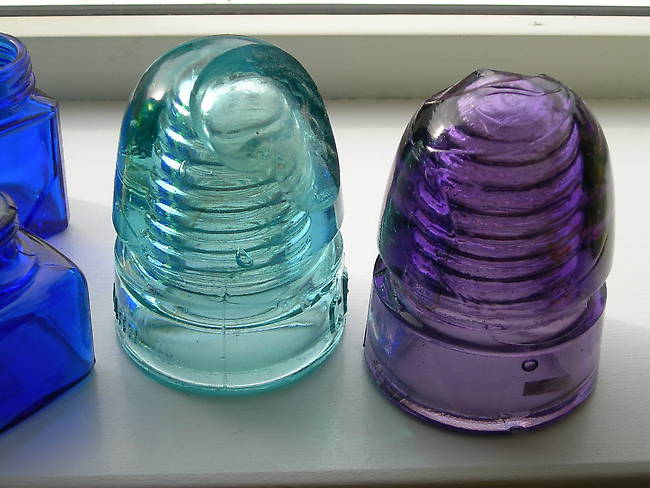Can you call these factory mint ???
By Bob Scafe; posted March 14, 2008
View Original: Click to zoom, then click to magnify (1024 x 768) 181KB

|
I'm sure that is not your first reaction, as both insulators have large areas missing from the domes. So, let me spin my tale, give you a " what if " situation, and then I'll ask you again. You may change your mind. What is the problem with these insulators, other than there is part of the domes missing. Visualize the mould awaiting a glob of molten glass, which is now released, and it flows down and settles into the mould. The plunger descends, rotates, pauses, rotates in reverse and retracts. You now have a threaded insulator, waiting to cool sufficiently that it may be removed from the mould and placed in the lehr to complete the process. During the pouring process, a very small quantity of air was trapped between the glob of glass, and the bottom of the mould [top of the dome] There are several possibilities here. Most likely, the pocket of air remains between the glass and the mould, leaving a shallow hole in the dome when the glass cools. The next is that the glass envelopes the air pocket, and it is now flattened out within the glass when the plunger descends into the insulator . As the glass cools and contracts, the thin outer layer of glass flakes off, leaving the lehr with a shallow hole on the surface of the dome, BUT, can it still be called " factory mint " ? Neither of the 2 insulators shown has a point of impact, nor is there any bruised or broken glass. In some places, the edges are actually smooth and rounded as opposed to having sharp edges. I'd appreciate hearing your thoughts whether these are factory mint or not, and your reasoning. I know, some will say the chances are one in a million, but then, there were several hundred million insulators made, so the chances just got a lot better. When you think about it, these are simply open bubbles on a large scale. Your thoughts please. |